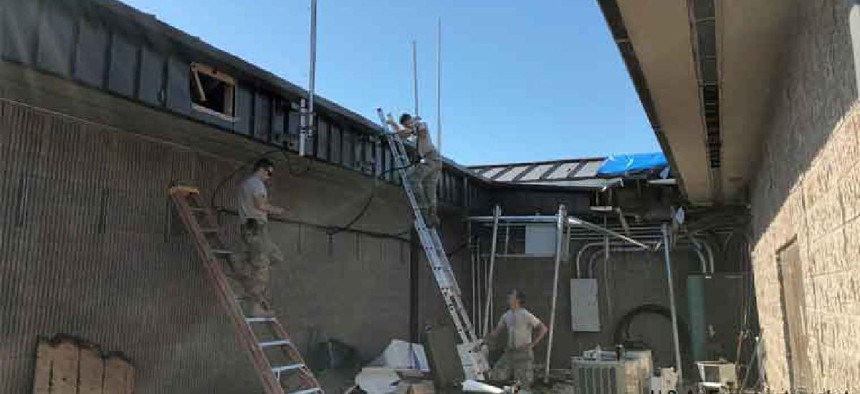5G powers Air Force 'smart base of the future'


Connecting state and local government leaders
The Air Force is working with AT&T to rebuild and modernize communications infrastructure at Tyndall Air Force Base with 5G-powered capabilities.
As Tyndall Air Force Base in Florida’s panhandle continues to rebuild after taking a direct hit from Hurricane Michael in 2018, it’s getting not only a makeover, but a modernization, too.
The Air Force is working with AT&T to create a “smart base of the future,” including reconstructing and transforming the Tyndall ’s communications infrastructure with 5G-powered capabilities. Although the base buildout is expected to take three to five years, AT&T will light up 5G in mid-2020, enabling Tyndall to start taking advantage of benefits such as support for augmented and virtual reality (AR and VR).
“The Department of Defense really stands at the cusp of some of the most revolutionary changes in the market that they’re leading, and I think they’re game-changing,” said Mike Leff, vice president for defense at AT&T Global Public Sector. “The power of 5G has the potential to revolutionize and transform DOD operations, particularly on military bases, to significantly enhance mission readiness and enabling new mission capabilities like never before.”
One potential use case he pointed to is supporting flight-line operations by streaming massive amounts of data to warfighters using data platforms, sensors and aircrafts’ onboard systems so that crews on the ground and in the sky can more easily communicate.
Another application is security. Tyndall will be able to use 5G for wide-scale video, surveillance and analytics that cover everything from the flight line to physical perimeter security, such as monitoring gates with license plate readers. Similarly, public-safety operations could benefit. For example, a smart base could use sensors to pinpoint the sound of gunfire and notify emergency responders to a possible active shooter.
A third area is training -- an especially important use case for 5G given that Tyndall is home to the 325th Fighter Wing, which has the mission to provide combat-ready air dominance training for F-22 and potentially F-35 aircraft. This is where AR and VR can be particularly useful. Airmen and -women can use 5G-powered AR and VR tools and systems to simulate warfighting conditions, improving readiness.
AR and VR can also ease maintenance, Leff said. Rather than lugging paper blueprints and repair manuals around the base, maintenance workers can wear smart goggles or use tablets to overlay documentation directly on the equipment in question.
“You’ve got now teams on the ground that have the ability to pull up blueprints virtually, and you’ll see the physical beginning to blur with the virtual, where maintenance teams can not only work on very large, complex systems," he said. The technology will improve not just troubleshooting, but maintenance as well. "There’s a predictive aspect on the maintenance side where you can detect and predict equipment failures sooner -- before the fail -- which would free up a lot of time downstream,” he said.
The result will be a base not unlike a smart city, which has a suite of technologies that improve citizen interactions and are often focused on safety and sustainability, Leff said.
“Think about a network of sensors, wearables, [internet-of-things] devices that are powered by 5G, that use cloud and edge computing, that can utilize these connections and the massive amounts of data that they collect," he said. Installations with those near-real-time capabilities can "provide actionable intelligence to help achieve the mission and ultimately give the military a competitive and decisional advantage,” Leff said. It “really has the potential to allow the military bases to be safer, operate more efficiently and probably more effectively for mission readiness.”
Under the agreement between the Air Force and AT&T, the company will also deliver and manage commercial and private enterprise IT capabilities such as mobility, cloud access, unified communications, broadband and connected devices. The service will also equip first responders on the base with FirstNet, the dedicated nationwide communications platform for public safety that AT&T is building.
The Air Force has other 5G initiatives under way, too. It’s working with Verizon to bring 5G to 10 bases in Florida, Georgia, Indiana, North Carolina, South Carolina and Tennessee.
In fact, DOD overall has 5G efforts in place throughout the services. On Oct. 31, the department announced the selection of four bases as the first to host testing and experimentation for 5G technology. A request for proposals was issued in December focuses on establishing a dynamic sharing testbed, integrating AR and VR into training and creating smart warehouses to use 5G’s ability to enhance logistics operations.




